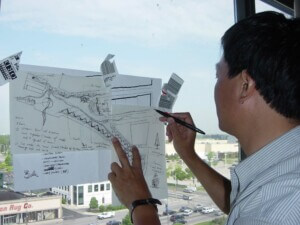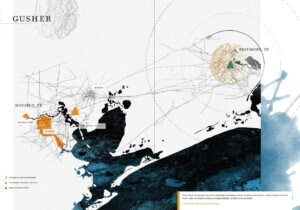What if, instead of washing out, a city could float when it floods?
“Our system takes the onus of flood protection off the taxpayer and puts it onto the developer, the owner, and the builder. Why is the public subsidizing irresponsible construction in floodplains when there are better ways to build?” asked Greg Henderson, the founder and CEO of Los Gatos, California–based Arx Pax. The company has developed a new technology to boost resiliency in coastal areas and flood zones by building not on land, but over water.
The SAFE Building System is a self-adjusting, three-part floating foundation made of precast concrete pontoons that can support not only homes, but towers and city blocks. Far from an engineer’s fantasy, the system has precedent in the Evergreen Point Floating Bridge, which carries Seattle drivers across Lake Washington to the suburbs, and the Mega-Float, the world’s largest airport over water in Tokyo, Japan.
Though the ambitious system is buoyed by Silicon Valley optimism, the design inspiration for the project is humble. Houseboats, like the ones in Mission Bay that Henderson studied in architecture school at UC Berkeley, are impervious to earthquakes and floods—a solid model of how buildings could float above disaster.
Like houseboats, which vary by region and the owner’s budget, the SAFE system is replicable but responds to local conditions. At every site, a few feet of water is introduced to float the structures before any floods, like a swimming pool for buildings. The pontoons can be made of myriad materials in response to local conditions; Henderson is adding fly ash and other admixtures to ordinary Portland cement to create pontoons that have a lifespan of hundreds of years. In an explainer video, Arx Pax uses Miami Beach, Florida, as a model to demonstrate how the SAFE system could be implemented.An idea, though, is only as feasible as its permitting. Arx Pax is researching local regulations around the installation and maintenance of in-ground pools for guidance on how to pitch the SAFE system to municipalities. California’s Marin County, for example, has rules that govern houseboats, “so there is regulation out there,” said Henderson. “We’re pushing some envelopes, but we’re not doing anything new. We’re pulling together existing technologies so it should be easy for people to get behind [the system].”
Henderson wants communities—and the federal government—to rethink the reactive approach to disaster planning. The Federal Emergency Management Agency (FEMA)’s rebuild and retreat model, he said, doesn’t work when, by some estimates, sea levels could rise more than six feet by 2100. Building on stilts or doing nothing are less cost-effective than the SAFE system long-term, Arx Pax argues, because more frequent extreme weather events will continue to destroy coastlines and cities on floodplains. Even levees have problems (beyond breaches): Their slopes take up precious real estate, a proposition that may be feasible in some areas but less desirable in places with high land costs.
For cities in climate-change denial, there is still time to reconsider approach to hazard mitigation. Right now, Arx Pax is in talks with FEMA to adopt the technology, and the company is working with a few flood-prone U.S. communities that Henderson declined to name. Internationally, Arx Pax is doing a pilot project with Republic of Kiribati (a small, low-lying island nation in the Pacific Ocean) to increase its resiliency.










